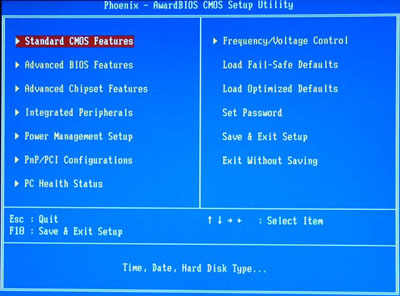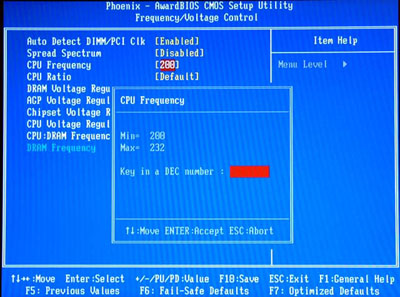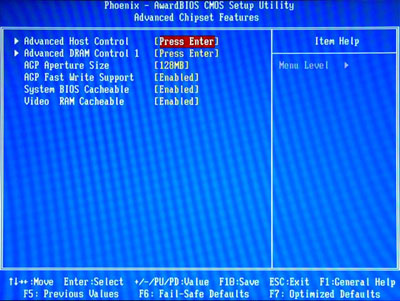DFI 748-AL: First Look at SiS 748
by Wesley Fink on August 30, 2003 12:00 AM EST- Posted in
- Motherboards
DFI 748-AL: BIOS and Overclocking
DFI uses the familiar Award BIOS for the 748-AL. The BIOS is the first “Performance” BIOS that we have seen used on a SiS 748 board, and the overclocking options are very complete for a board designed to sell for a low price.
The Main BIOS Screen layout includes the standard options plus selections for Frequency/Voltage Control, Advanced Chipset Features for system timings, and PC Health Status.

CPU FSB and multiplier ratios are adjusted in the Frequency/Voltage Control menu. Voltage adjustments are included for Core Voltage, Memory, AGP, and chipset voltage. This is a very complete set of controls for overclocking.

CPU only extends to 232FSB. This is probably adequate for a board without AGP/PCI lock, but we would have been happier to see a range to 250. Since SiS has implemented a “Fixed PCI/AGP” setting on other chipsets, we hope it is also possible on the 748 with a BIOS update.

SiS is famous for the incredible array of memory options they have provided in chipsets like the 645/655 series, so we hoped we would be seeing a full range of memory ratios. The only choices are SPD, 1:1 (DDR400), and 6:5 (DDR333). We hope to see more choices in the shipping BIOS.
System and Memory Timings are adjusted in the Advanced Chipset Features menu.

Memory adjustments are in submenu, called “Advanced Dram Control 1”. The Evaluation ROM has a very limited selection of settings. The only adjustments are “Normal” and “Performance”, and CAS values can only be selected if Performance is enabled. We suspect there will be additional memory timings available on the release DFI 748-AL.

CAS 2 would not work with our Corsair 3200LL, which is SPD-timed at 2-2-3-6. Normal appears to set timings of 2.5-4-4-8 at SPD with the Corsair. Performance and CAS 2.5 set 2.5-4-4-5. Even with these very conservative timings, the DFI performed extremely well, but if the release BIOS improves the memory timings, we sill see a whole new level of performance.

PC Health functions are included for monitoring functions, such as System and CPU temperatures, fan speed monitoring for 2 on-board fan connections, vCore, and Power Supply readings for all rails. DFI also offers options for setting shut-down temperatures for automatic system shut-down if a CPU overheats.
BIOS options for the 748-AL would be excellent on any board, but they are even more surprising on a SiS 748 board. We hope DFI will revamp the options for memory timings in the release BIOS, which are the only weak section of an otherwise strong BIOS. Options to 250FSB and PCI/AGP fix would also be welcome additions.
FSB Overclocking Results
In the past, when reviewing AMD motherboards, the only test method used at AnandTech was to remain at default multiplier while increasing the FSB until the highest stable FSB was reached. This method does report useful information for comparison, but there is another method for overclocking many recent Athlon motherboards. Most recent Athlon XP/Barton CPUs are unlocked or they behave as unlocked on recent motherboards. This allows overclocking by changing the multiplier or ratio of the Athlon CPU. On recent motherboards and Athlon CPUs, this requires no special “modification” to the board or CPU — it is now a standard feature available to any end-user who wants to use it. We have seen cases, like the DFI 748-AL that we are testing, where the FSB overclock is average or poor due to the lack of a PCI/AGP lock; when in fact, very high overclocks were possible by adjusting just the multiplier or both the multiplier and FSB.Since the multiplier or ratio adjustment is now a standard feature on many nForce2, KT600, and SiS 748 motherboards, we are adding a second overclocking test to Athlon reviews. We will also change multipliers and/or voltage on a reported air-cooling setup to find the highest stable overclock we can find using multiplier, voltage, and FSB with our standard components. We are not just looking for the highest number we could achieve. We will be trying to find a stable combination to provide an overclock that can still handle our stress testing. Both standard multiplier/highest FSB at default voltage and highest stable overclock will be reported.
The following setup was used on the DFI 748-AL for FSB overclocking:
| Front Side Bus Overclocking Testbed | ||||
| Default Voltage | Maximum Overclock | |||
| Processor: | Athlon XP 2500+ (Barton Core) |
Athlon XP 2500+ (1837MHz) (Barton Core – 11x166) |
||
| CPU Voltage: | 1.65V (default) | 1.775V | ||
| Cooling: | Thermalright SK-7 with 80mm Thermaltake Fan | Thermalright SK-7 with 80mm Thermaltake Fan | ||
| Power Supply: | Powmax 350W | Powmax 350W | ||
| Maximum OC: | 2332MHz (+27.3%) (11x212FSB) |
2450MHz (+33.4%) (12x204) |
||
Without a Fixed PCI/AGP bus speed, we expected the 748-AL would be limited in overclocking ability. The maximum stable overclock we could achieve at default voltage and multiplier was 212FSB. This is about the same as achieved on the better VIA KT600 boards, so we suspect that we may be seeing the AGP speed limit of the Radeon 9800 PRO video card more than the actual limit of the board. Fortunately, the DFI offers a full range of multipliers from 5X to 21X, and they work very well. We were able to set the FSB speed to a fixed 200 with the Dip switches on the board, increase the multiplier to 12.0 from 11.0 and mildly overclock the bus to 204 to achieve 2.45Gz with our Barton specified to run at 1.833GHz. This 33%+ overclock is close to the best we have achieved with this chip.
The nForce2 chipset, with PCI/AGP lock and a full range of multipliers, allows more possibilities with higher FSB options, but the DFI does allow the chip to reach its maximum speed with increased multipliers near one of the fixed FSB settings, like 200 and 166. What you can’t get without an AGP/PCI lock, are working settings like 10x240. The video card or PCI peripherals will likely give up before you can reach this setting.
The performance achieved from a board that will sell at a bargain price was excellent. The DFI is the only SiS 748 board with multiplier adjustments, and it does make a large difference in performance. We would be happier to see both a PCI/AGP frequency lock, and multipliers, but we were able to achieve excellent performance increases with the multiplier and FSB adjustments.










22 Comments
View All Comments
Anonymous User - Saturday, August 30, 2003 - link
too little, too late.dvinnen - Saturday, August 30, 2003 - link
yay, SIS!Now lets bust out the ALi chipsets